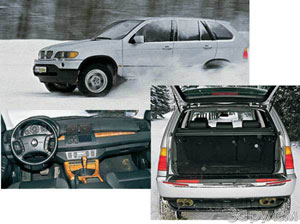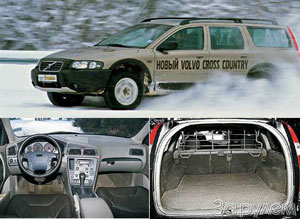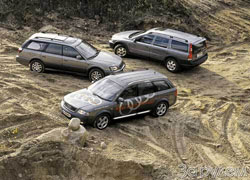Test drive Volvo XC70 (V70XC) 2000 - 2004 station wagon
Whose drive is more active?
The luxury of the burgher and the practicality of the VikingThe all -wheel drive station wagon BMW X5 debuted at the Detroit car dealership in 1999. It is equipped with two
V-shaped engines: eight, 4.4 l, 286 l. With. or six, 3.0 l, 231 l. With. The gearbox is an automatic five -speed with electron -hydraulic control.
The world premiere of all -wheel drive station wagon VOLVO V70XC took place in 2000 at the Detroit salon. The car is equipped with a 200 liter gasoline in -line in a five -cylinder engine. With. With a low -pressure turbocharged. The gearboxes are five -speed, mechanical or automatic.
Is it possible to compare the two cars so different in the image and price of the car as BMW X5 and Volvo V70xc? Of course, you can’t. But if you want to expand your knowledge of the modern all -wheel drive, then it is possible and even necessary. Indeed, despite the differences, these cars have something in common. Firstly, the wheel formula 4x4. Secondly, both occupy a niche between full-fledged all-terrain vehicles and ordinary cars. And thirdly, the BMW X5 and Volvo V70XC in terms of release is by no means leaders in the production programs of firms. They expand the model range, form the image of their creators, but are oriented mainly on the American market, where transport for lovers of active lifestyle is now held in high esteem. It is all the more notable that both new products are now found on Russian roads - more often on the capital. It can be seen that the active image of the American movement is natural for our drivers. Hence the interest of wealthy citizens in such a technique. Let's break the traditional presentation scheme and start with the main one - compare the designs of original machines, their running qualities, and leave the interiors for dessert.
The torque of truth
 Having released the X5 model, the Bavarians acted as legislators of fashion. The novelty was dubbed a sports and active vehicle (Sportivity Vehicle), announcing the creation of a new class. Indeed, a 4.4-liter with a working volume of 4.4 liters hidden under the hood is obligated in its own way: a dynamic shell capable of flying away in 200 km/h on an autobahn, calling the tongue simply does not turn the tongue. In addition, BMW insists that only noble cars produces and are not going to exchange for plebeian dirt grounders. On the other hand, the shape of the body, a high road clearance, large wheels, massive thresholds suggest - anything, but not a car. Summary and a transmission is a constant all -wheel drive. An asymmetric differential distributes the torque in the ratio of 38% - on the front axle, 62% - to the rear. Except for the adaptive five -speed automatic gearbox, the transmission is quite conservative. However, in difficult road conditions, the most modern electronic systems of the third generation come to the rescue of the driver. Among them are anti-locking (ABS), control of braking in corners (SVS), restrictions on the decline (HDC), dynamic stability control (DSC) with anti-boogging subsystems of ADB-X and ASC-X and dynamic control over the braking (DBC). In general, while we take the word: BMW X5 is an original car with a sports bias for the active world.
Having released the X5 model, the Bavarians acted as legislators of fashion. The novelty was dubbed a sports and active vehicle (Sportivity Vehicle), announcing the creation of a new class. Indeed, a 4.4-liter with a working volume of 4.4 liters hidden under the hood is obligated in its own way: a dynamic shell capable of flying away in 200 km/h on an autobahn, calling the tongue simply does not turn the tongue. In addition, BMW insists that only noble cars produces and are not going to exchange for plebeian dirt grounders. On the other hand, the shape of the body, a high road clearance, large wheels, massive thresholds suggest - anything, but not a car. Summary and a transmission is a constant all -wheel drive. An asymmetric differential distributes the torque in the ratio of 38% - on the front axle, 62% - to the rear. Except for the adaptive five -speed automatic gearbox, the transmission is quite conservative. However, in difficult road conditions, the most modern electronic systems of the third generation come to the rescue of the driver. Among them are anti-locking (ABS), control of braking in corners (SVS), restrictions on the decline (HDC), dynamic stability control (DSC) with anti-boogging subsystems of ADB-X and ASC-X and dynamic control over the braking (DBC). In general, while we take the word: BMW X5 is an original car with a sports bias for the active world.  And what about Volvo? Here, fortunately, they did without revolutions in the classification. Very spectacular and original outwardly, the V70XC is actually a modification of the front -wheel drive station wagon V70. The manufacturer does not hide this. And even if you are not misleaded by the daring appearance, coupled with the decisively sounding Cross Country on the trunk lid (by the way, in the free interpretation, this combination means something like giving the heat in the village). External protective elements, increased road clearance, all -wheel drive - attributes of a station wagon of increased patency. It is precisely increased, and not infinite, which should not be forgotten by the driver of Volvo, who lives in the most active way. The Volvo V70XS is equipped with a painful 200-horsepower engine with a low-pressure turbocharged. Unlike BMW, the Volvo motor is located in the engine compartment transversely. For a Swedish company, such power units and layout have already become traditional.
And what about Volvo? Here, fortunately, they did without revolutions in the classification. Very spectacular and original outwardly, the V70XC is actually a modification of the front -wheel drive station wagon V70. The manufacturer does not hide this. And even if you are not misleaded by the daring appearance, coupled with the decisively sounding Cross Country on the trunk lid (by the way, in the free interpretation, this combination means something like giving the heat in the village). External protective elements, increased road clearance, all -wheel drive - attributes of a station wagon of increased patency. It is precisely increased, and not infinite, which should not be forgotten by the driver of Volvo, who lives in the most active way. The Volvo V70XS is equipped with a painful 200-horsepower engine with a low-pressure turbocharged. Unlike BMW, the Volvo motor is located in the engine compartment transversely. For a Swedish company, such power units and layout have already become traditional. The basis of a full -wheel drive transmission is an automatic front -wheel drive gearbox, with a compact corner gearbox, which transfers torque to a cardan shaft. The latter is connected with the differential of the rear bridge over the Wyeschers. On the dry asphalt road, the Volvo V70XS behaves like a front -wheel drive car. But it is worth the drive wheels to start slipping, as Wyskoft will immediately pass the torque to the rear axle. The role of inter -axial blocking and front and rear is played by the electronic anti -tuxurious system Tracs without mechanical components. According to the ABS channels, it slows down the masking wheel, allowing you to realize traction through others, which have better clutch. Tracs helps to start on slippery roads and maneuver at low speeds. When the speedometer is more than 40 km/h, the system automatically turns off. And now we will find out how these symbiosis mechanics with electronics behave on the go.
WILL AND MIND
 Cars are almost completely loaded - in addition to drivers in the salons of three passengers. Under the wheels, snow is not on the asphalt to demonstrate talents of all -wheel drive. Well, let's go!
Cars are almost completely loaded - in addition to drivers in the salons of three passengers. Under the wheels, snow is not on the asphalt to demonstrate talents of all -wheel drive. Well, let's go! BMW starts on slippery coating, as if on a dry highway. Under the loud snort of sports silencers, a powerful engine briskly accelerates Makhin with a full mass of more than 2.5 tons far over a hundred. Still, four leaders are great! With a monotive, such a number in the rolled snow would hardly be successful. But we drive up to the winding highway imitating the mountain road. Smart electronics immediately take the reins of government - easily compensates for both the demolition of the front axle and the absence of the rear. Stabilization systems even cope with gross provocations: an inflated speed of entering the turn, sharp actions with a steering wheel and gas, braking on the floor on a turn of turn. The unbridled burrows x5 is completely tamed! Under difficult conditions, a driver of any qualification will be able to steal a car at ease. BMW will forgive him all mistakes, or rather - almost everything.
The wounded pride makes the experienced rider turn off cunning systems - let the German feel what the tester can do with experience. Have mercy, there is no trace of the former imposition of the car! The driver in sweat is trying to cope with almost three hundred horses alone, without electronic assistants. The slightest mistake, one incorrect movement of the steering wheel or gas threatens with loss of control. The transmission, deprived of support for stabilization systems, demonstrates the rear -wheel drive in nature, and the car as a whole - excess turning: the answer to the addition of traction is a breakdown in the ski. Where are you, a saving button, return the former comfort and calm! We sacrifice pride - let the electronic mind delve into the intricacies of dosage of torque.
 I must admit, a non -hut will also start on the snowfield. At the very beginning, the anti -wings system helps with a complete drive. But then, when the speed reached 40 km/h
I must admit, a non -hut will also start on the snowfield. At the very beginning, the anti -wings system helps with a complete drive. But then, when the speed reached 40 km/h In a word, it is easy and pleasant to control the country's all -wheel drive Cross. In regular modes, Volvo holds the road tenaciously, quickly responds to the driver’s actions, and when he wants, he will be chewed. But unlike BMW, the electronics of which will stop any leprosy, as soon as they will become dangerous, Volvo can be missed. Such is the reckoning for the will given to the person.
We land passengers and repeat the route: this is a surprise! It is no accident that many, accustomed to classics or front -wheel drive, cannot find a common language with 4x4 cars - they call them incomprehensible. The burrows of the empty BMW have a cool shift towards the front -wheel drive, and Volvo became more often revenge on the tail; The rotation of both approached neutral. It turns out that the behavior of all -wheel drive is highly dependent on the load. And you need to remember this!
Before checking the off -road qualities, the car visited the lift. Inspection of the components of the chassis and transmission confirmed - the passenger genealogy of Volvo is more noticeable. BMW looked much more impressive. However, here and there there were easily vulnerable details. Remembering this, they stoiled in SUV. And what? Car passage is comparable. Volvo lags just a little: with the same road lumen with BMW, he has more front and rear overhang.
In short, the all-terrain ambitions of the owner of the X5 or Volvo V70XS will quite satisfy the trip on the path of an unpeeled after abundant snowfall to a multi-storey cottage in some elite village. That is, where the car, most likely, will be bogged down. You can’t count on more. In the end, a picnic in the country is also an element of an active lifestyle, not everyone to go to Camel Trophy.
Inside the Bavarets is luxurious: black leather, massive wood inserts, a cool audio system. Interpreting about controls, ease of landing in front and back? Complete, this is BMW! And for exclusivity, you will get an ultra-modern color information terminal: TV screen, music center panel, route computer, GPS navigator and diagnostic device at the same time. And yet, with a lot of advantages, the interior X5 is somewhat cold. No, the heater is just warming excellently. Human warmth lacks all this luxury. You will find him in the cabin of Volvo. It is more modest here (relatively, of course!), But homely is comfortable. The Swedish style implies a carefully selected color scheme: the body is painted with cream metallic, a bumper and a plastic body kit are dark brown. At the same time, the upholstery of the cabin is light beige, and decorative inserts and skin on the seats are brown. A pleasant combination. As for the functionality, the convenience of governing bodies, BMW will probably not yield here.
WHAT TIME IS IT NOW?
Before us are two cars for an active lifestyle. Exclusive and luxury against practicality and style. Bavarians seem to emphasize excesses: isolation of the design from other BMW models, the complexity of transmission and electronic control systems, the power of an extraordinary motor. Such a pleasure is not just expensive, but very expensive - 85 thousand dollars. Against this background, gasoline costs are faded, although during the testing of X5 it easily swallowed 25 liters of gasoline per hundred. Volvo, no matter how he worked, did not exceed the bar of 20 l/100 km. Yes, the Swedes went the other way: support on the base model and successful, previously tested technical solutions; Rich, but without merchants, equipment. Such a car is better suited for everyday use, and it costs two times cheaper.
 Stop, we agreed not to compare the cars in the forehead - and now that we have figured out the features of different schemes of all -wheel drive, we will try to delicately summarize. The owner of the BMW X5 seems to be a man whose wrist is ticking the golden chronometer Rolex, decorated with diamonds, but the driver of Country Cross, most likely, learns the time, looking at the elegant stainless steel long. And at the same time, both lead a completely all -wheel drive lifestyle. And the system is delicately disconnected, the acceleration intensity does not fall. To that, on the mountain road, the driver receives freedom of action. At high speeds, only ABS works at Cross Country, and traction control is resting. On the one hand, this is good - the uniqueness of reactions does not interfere with the planned maneuver. But there is also the reverse side of the coin. The pilot deprived of an annoying guide must have a qualification that allows you to confidently and reliably ride in difficult conditions. So, on a winding snow-covered highway, Volvo behaves in front of the drive. In marginal situations, it demonstrates insufficient rotation, shows a tendency to demolish the front axle, but also makes it possible to play with a traction. Everything is familiar and familiar. Only occasionally picks up the back, but not at all obsessively.
Stop, we agreed not to compare the cars in the forehead - and now that we have figured out the features of different schemes of all -wheel drive, we will try to delicately summarize. The owner of the BMW X5 seems to be a man whose wrist is ticking the golden chronometer Rolex, decorated with diamonds, but the driver of Country Cross, most likely, learns the time, looking at the elegant stainless steel long. And at the same time, both lead a completely all -wheel drive lifestyle. And the system is delicately disconnected, the acceleration intensity does not fall. To that, on the mountain road, the driver receives freedom of action. At high speeds, only ABS works at Cross Country, and traction control is resting. On the one hand, this is good - the uniqueness of reactions does not interfere with the planned maneuver. But there is also the reverse side of the coin. The pilot deprived of an annoying guide must have a qualification that allows you to confidently and reliably ride in difficult conditions. So, on a winding snow-covered highway, Volvo behaves in front of the drive. In marginal situations, it demonstrates insufficient rotation, shows a tendency to demolish the front axle, but also makes it possible to play with a traction. Everything is familiar and familiar. Only occasionally picks up the back, but not at all obsessively. Text / Vadim Kryuchkov
Photo / Vladimir Knyazev
Source: The magazine "Driving"






